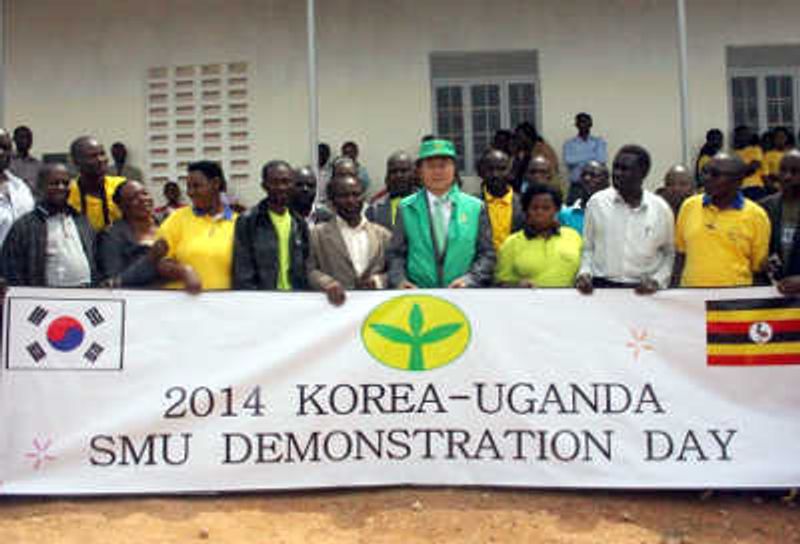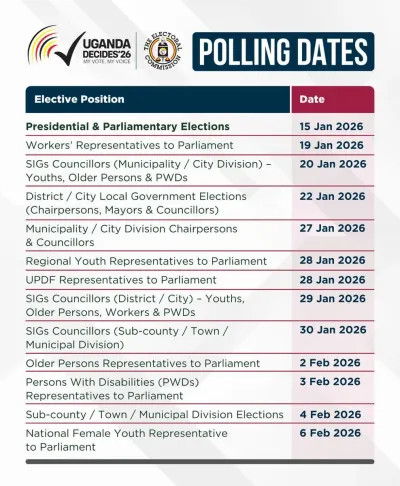

South Korea Ambassador Park Jong Dae (in Green Jacket) stands with members of SMU Uganda after cleaning Kyengera township
As a way of changing the mindset of ordinary Ugandans from dependency on donors and government, community work and diligence as the driving forces from poverty to prosperity.
Championed by Ambassador Park Jong-Dae, in partnership with Korea International Cooperation Agency (KOICA) and local leaders, the South Korean delegation was in Kyengera recently to launch the award winning Saemaul Undong or New village movement to provide practical examples of how development can take place from the grassroots up.
Running under the theme; “2014- Korea-Uganda Demonstration Day”, the event was meant to demonstrate the need for community work, self governance and cooperation as the foundation for development.
Ambassador Park Jong-Dae, members of KOICA and Saemaul Undong Uganda members together with the local leaders engaged the residents of Kyengera including market vendors, boda boda riders, primary and secondary students as well as police into a mass cleaning exercise. The exercise involved cleaning of the Masaka highway road, Nabaziza central market and the taxi park.
Ambassador Park hailed Uganda’s acceptance for the initiation of Saemaul Undong as a clear testimony of its willingness to learn lessons from some of the most successful development approaches ever developed.
He said: “Saemaul Undong focuses on mobilizing people for self improvement so that they can transform their rural areas into developed cities. People understand that when they come together, they can develop themselves. Therefore, the initiation of this program will draw people together to engage in developmental projects for their communities.”
Apart from cleaning the village, Ambassador Park revealed that with the initiation of Saemaul Undong, Korea’s Embassy will be working with community leaders and members to rehabilitate homes, roads and also establish farming developmental projects.
He noted that two pilot projects are already in advanced stages in the villages of Kitemu, Katerega and Busanja.
With these projects, Jiin Lee, Administrator at Korea’s Embassy, noted, they try to persuade community members by setting up a model of Saemaul Undong and encourage them with ‘a can do it’ spirit.
“We tell them that they can change from where they are and develop their communities by not waiting for the government to develop them but by doing it themselves through practicing Saemaul Undong slogans of diligence, self-help and cooperation.”
Relevance of Saemaul Undong in Uganda
David Ssali, initiator and manager of Saemaul Undong Uganda Limited underlined the fact that South Korea was able to achieve supersonic economic growth and development between 1960 to 1980 thanks to Saemaul Undong.
At Uganda’s independence in 1962, South Korea had a gross domestic product – a measure of national wealth – equivalent to that of Uganda. However, fifty years since then, the Asian country has become one of the fastest growing and richest countries in the world. South Korea is ranked among the ten biggest exporters with strong industries in electronics, ship building, oil and petroleum.
New hope for Uganda’s development
As was the case in South Korea, Ssali believes that Saemaul Undong is Uganda’s best hope for transforming from dependency to development.
He blamed the prevailing top-down system of planning and resource allocation as a major weakness. He noted that the New Village Movement uses a bottom-up practical exercise to determine resource allocation.
Saemaul Undong was first implemented by South Korea’s President Park Chung Hee in 1970 to develop the rural South Korea’s economy which had greatly suffered from the aftermath of a bloody civil war which had ended in 1953 with the separation of the country into North and South Korea.
Ssali explains that the new village movement was characterized with its emphasis on community driven development whereby the improvement of people’s lifestyles included the whole community but not just individuals.
Jiin Lee says President Park wanted to develop the rural areas because there was growing inequality as evidenced in the differences in standards of living between the nation’s urban centers which were swiftly industrializing and the rural villages which continued to be swamped by poverty.
In the early stages of the movement, Saemaul Undong focused on improving the basic living conditions of the people such as housing, sanitation, access roads and later moved on to bigger community projects such as building of village roads, schools, health centres and libraries.
In order to encourage community members to participate in the development process, she added that the movement had to change people’s attitudes by promoting the movement’s slogans of diligence, self-help and cooperation.
While the movement promoted self-help and cooperation among the rural people, Ssali says the central government acted as a motivator by providing free materials like cement to each participating village.
Encouraged by the success in the rural areas, the movement spread like wild fire through factories workers and urban areas and became a nationwide modernization movement which has made South Korea one of the richest countries at the moment.














Sunrise Admin
Leave a Comment
Your email address will not be published.